Chmod Numbers Linux

Chmod 777 755 655 644 And More Permissions Linux Files Tutorials

Linux File Permissions Tutorial How To View And Change Permission

What Does Chmod 775 Mean Quora

Chmod 777 755 655 644 And More Permissions Linux Files Tutorials
Why Does Doing Chmod 777 Not Make A File Executable But Chmod 755 Does Isn T 777 Greater Than 755 Quora

Chmod 777 What Does It Really Mean Make Tech Easier
At this point, you might wonder why we are using a three-digit number (744) after the chmod command.

Chmod numbers linux. Bash, Shell, Terminal, Command Line cheat sheets linux Ubuntu. The second chmod number is the group permission;. Chmod by the Numbers.
The chmod command changes the access permissions of files and folders. Chmod 444 file - Allow read permission to owner and group and world chmod 777 file - Allow everyone to read, write, and execute file. Chmod 700 foldername will give read, write, and execute permissions for the user only.;.
Command chmod 666 means that all users will have read and write permissions. I think that is it, there might be some other options as well, consult the man page. The numeric value can take 3 or 4 numbers.
Special, User/Owner, Group, and Others in that order, when working with the four-number chmods, with that first number being special bits that can be set. It is common to use the basic chmod command to change the permission of a single file. Chmod stands for “Change Mode” and is used to modify the permissions of files and directories in a Linux based system.
In Linux, access to the files is managed through the file permissions, attributes, and ownership. It turns out that you can also set the mode numerically. I’ll also explain some the popular terms like chmod 777 or chmod 755 or chmod -r.
Linux file permission is a very important aspects in terms of security issues for the system administrator of Linux Operating System. This manual page documents the GNU version of chmod. Chmod 001 file - execute by world To combine these, just add the numbers together:.
So to add read permissiones for people in the files group I would do chmod g+r file. The third chmod number is the other’s permission. Number 1 means that you grant execute rights, number 2 means that you make the file writeable, number 4 means that you make the file readable.
Chmod 4555 equates to the following:. They are list of letters that specifies whom to give permissions. As you have to define permission for each category (user, group, owner), the command will include three (3) numbers (each representing the summation of privileges).
It’s been present in Linux and other Unix-like operating systems since the 70s, in AT&T’s Unix Version One, but in the time it’s been in use, a number of access_control_lists have been added to increase the flexibility of the command. The chmod command uses a three-digit code as an argument. There is actually a fourth digit on Linux systems, that precedes the first three and sets special access modes.
Chmod Command in Linux Linux File Permission Introduction to Linux File Permission. In Linux, you can easily change the file permissions by right-clicking the file or folder and select “Properties”. $ sudo chmod OPTIONS numeric_value filename.
The leftmost digit represents the permissions for the owner. Up to this point, we’ve been setting the mode with letters. The chmod command with the -R options allows you to recursively change the file’s permissions.
9 Comments Originally posted October 13, 14. You can also read more about modes on Unix systems with 'man 1 chmod' and 'man 2 chmod'. To recursively set permissions of files based on their type, use chmod in combination with the find command.
Chmod 744 file name By executing this command, the owner can read, write, and execute the file (rwx). Actually, chmod Command in Linux plays a greater role to keep all the files and directories of the system safe and secure so that no unauthorized person. In Linux, you will often need to make use of the chmod command.
As systems grew in number and types of users, access control lists were added to many file systems in addition to these most basic modes to increase flexibility. 2 = -w-3 = -wx;. Changing permissions with chmod (numbers) Hi, I am unsure how the following command #chmod 755 file, results in the.
The second way to modify permissions with the chmod command is to use a number to specify each set of permissions for the file. The chmod command (abbreviated from change mode) is a Unix command that lets an operator tell the system how much (or little) access it should permit to a file. Linux File Permission :.
The chmod command is used to alter the permissions of a file. Chmod 770 (chmod a+rwx,o-rwx) sets permissions so that, (U)ser / owner can read, can write and can execute. An alternative option to specifying the above is to use the 3 digit octal number method (e.g 755), remember the following:.
4+2+1=7 $ chmod 777 sample.sh In the above example, you can see that the permissions are specified with a three digit number. Use the chmod command to set file permissions. I would like to change permissions of a folder and all its sub folders and files in one step (command) in Linux.
You really only need to memorize 1, 2 and 4 (if there were more options. The middle digit represents the permissions for the group members. In such cases, the chmod recursive option (-R or --recursive) sets the permission for a directory (and the files it contains).
If you enter a number with less than three digits as an argument to chmod, omitted characters are replaced with zeros starting from the left. Give read, write and execute permissions to everyone. For example, to add execute permissions for the owner of a file you would run:.
(Advice in this section is courtesy of Computer Hope). Linux - Software This forum is for. The letters u, g, and o stand for " user ", " group ", and " other ".
Edited Jun 10 ’11 at 19:57. Sooner or later in the Linux world, you will have to change the permission on a file or directory. Another way to use chmod is to provide the permissions you wish to give to the owner, group, and others as a three-digit number.
Rwxrwxrwx ) to see its value in other formats. Chmod 327 foldername will give write and execute (3) permission for the user, w (2) for the group, and read, write, and. Chmod Calculator is a free utility to calculate the numeric (octal) or symbolic value for a set of file or folder permissions in Linux servers.
The first chmod number is the owner permission;. Select the permissions you require below. (G)roup can read, can write and can execute.
The chmod command (abbreviated from change mode) is a Unix command that lets an operator tell the system how much (or little) access it should permit to a file. The chmod command in Linux/Unix is abbreviated as CH ange MOD e. Each permission is assigned a value, as the following table shows, and the total of each set of permissions provides a number for that set.
Here’s how it works:. When setting permissions using the numeric style/notation, use the syntax shown below:. A chmod command first appeared in AT&T Unix version 1.
How to use Check the desired boxes or directly enter a valid numeric value (e.g. GNU chmod will assume the mode you're giving it is octal anyway, but it's safest to prepend the zero. The general form is.
The second string shows the number of links that exist to the file. The first digit is for user permissions, second is for group and third is for others permission. For instance, let’s look at the test.txt file that we symbolically configured with the chmod u=rw,g=r,o=r test.txt command.
Owner (you) Group (a group of other users that you set up) World (anyone else browsing around on the file system). The tool will provide you with an octal code that corresponds to these permissions which can then be applied to relevant directories and files with chmod. Chmod has two operating modes:.
Chmod never changes the permissions of symbolic links;. This is done with the chmod command. In this article, I’ll share with you some of the practical examples of chmod command.
However, you may need to modify the permission recursively for all files within a directory. The number determines the file permissions. However, in most cases, 3 numbers are used.
Chmod Examples in Linux / Unix:. It may be used to add or remove permissions symbolically. How Is chmod Used?.
To change the mode of a file, use the chmod command. To change permission using the Linux chmod command we have to follow some syntax and rules. The syntax for changing the file permission recursively is:.
0 = ---1 = --x;. Read, write and execute:. Each row has 2 examples, one for setting that permission for a file, and one for a directory named ‘dir’.
Adding the numbers in each section results in permissions of 664. Because unix was written a long time ago (in computer years, at least), people who used it were fairly geeky and thought nothing of slinging binary, octal and hex around. There will be a Permission tab where you can change the file permissions.
This tutorial explains chmod command symbolic notation (r, w, x, a) and octal notation (0, 1, 2, 4) in detail with chmod command arguments and options. This example uses symbolic permissions notation. By using this command, we can set the read, write, and execute permissions for all three of the permission groups (Owner, Group and Other) in Linux.
Finally, if you see a + at the end of the modestring:. If you have any questions or feedback, feel free to leave a comment. Example 1) Assign permissions using numeric notation.
4 = r-5 = r-x;. This tutorial covers how to use the chmod command to change the access permissions of files and directories. Chmod 777 foldername will give read, write, and execute permissions for everyone.;.
This ensures that only authorized users and processes can access files and directories. The equals sign (" = ") means "set the permissions exactly like this," and the letters " r ", " w ", and " x " stand for "read", "write", and "execute", respectively. If you need to list a file's permissions, use the ls command.
View (u)ser, (g)roup and (o)thers permissions for chmod 555 (chmod a+rwx,u-w,g-w,o-w) or use free online chmod calculator to modify permissions easily. The command chmod changes the file mode bits of each given file according to mode, which can be either a symbolic representation of changes to make, or an octal number representing the bit pattern for the new mode bits. The standard UNIX way to show that a number is octal is to start it with a zero.
The Linux command to change permissions on a file or directory is chmod, which we like to read as change file mode. There's actually 4 attribute sets you can work with via chmod. To make your life easier, write the permissions grouped into sets of three letters.
6 = rw-7 = rwx For example:. All possible combinations are represented by a unique number. That’s why a unix admins will say stuff like mode 755 and the bits magically.
Chmod - Unix, Linux Command - chmod - To change access permissions, change mode. Let’s now delve and see different examples of chmod command. However, group and others are only allowed to read (r–).
In the terminal, the command to use to change file permission is chmod. The three digits of the chmod code set permissions for these groups in this order:. In Unix-like operating systems, the chmod command is used to change the access mode of a file.
The rightmost digit represents the permissions for the others. Set the permissions for a file or directory by using the chmod command. Using chmod with Absolute Permissions.
The chmod command, like other commands, can be executed from the command line or through a script file. Chmod 775 /opt/lampp/htdocs Is there a way to set chmod 755 for /opt/lampp/htdocs and all of its content including subfolders and files?. So that’s how permissions are displayed in Linux using symbols.
Chmod permission number explained. Write the permissions you want the file to have. Chmod changes the file mode bits of each given file according to mode, which can be either a symbolic representation of changes to make, or an octal number representing the bit pattern for the new mode bits.
(O)thers can't read, can't write and can't execute. I have already tried the below command but it works only for the mentioned folder:. The third string identifies the owner of the file and the fourth string tells what group the owner of the file is in.
Command chmod 666 means that all users will have read and write permissions. In short, “chmod 777” means making the file readable, writable and executable. Introduction to Linux - A Hands on Guide This guide was created as an overview of the Linux Operating System, geared toward new users as an exploration tour and getting started guide, with exercises at the end of each chapter.
Learn how chmod command is used to manage Linux permission levels (user, group and other) and types (read, write and execute) step by step with practical examples. Add up these numbers to specify needed rights. File/Directory permission is either Read or Write or executable for either user or group or others.
The chmod system call cannot change their permissions. The name is an abbreviation of change mode. The version of chmod bundled in GNU coreutils was written by David MacKenzie and Jim Meyering.
777 ) or symbolic notation (e.g. When we use the chmod command later on, you’ll see that you can change the permissions using either symbols or octal numbers. The references are used to distinguish the users to whom the permissions apply i.e.
Chmod command is useful to change permission for Files and folders in Linux/Unix. C an you provide more information about chmod command octal mode number notation?. The second way to represent the same permissions is by using octal numbers.
Edited Jun 10 ’11 at 19:57. The command is relatively simple to use and involves using.

Chmod Calculator Chmod Generator Chmod Command

The Basics Of The Chmod Command Pi My Life Up

9 Quick Chmod Command Examples In Linux

File Permissions How To Use Chmod Command Youtube
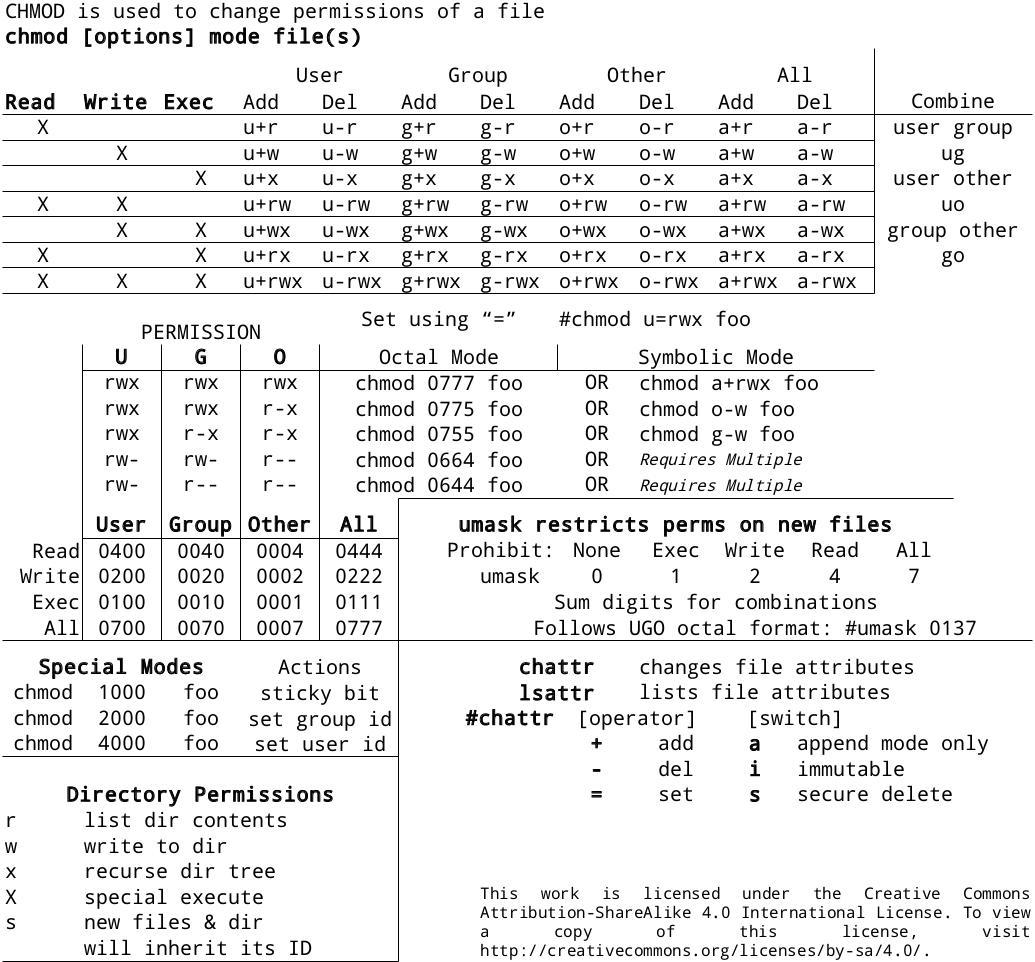
0xax Chmod Cheat Sheet Linux Cli Http T Co B5yd7pk1

Solved File Permissions In Linux Can Be Set Using A 3 Dig Chegg Com
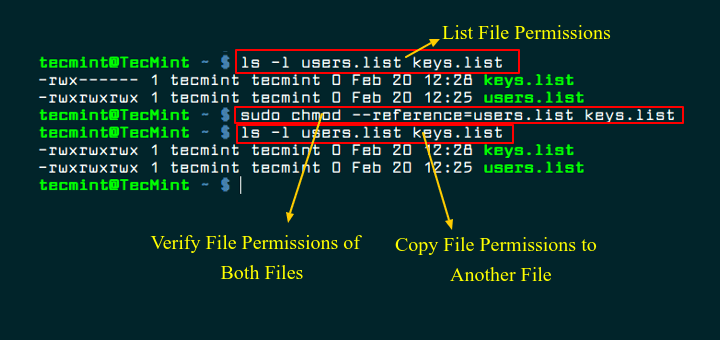
How To Copy File Permissions And Ownership To Another File In Linux
Linux Chmod Tips

Understanding Unix Permissions And File Types Unix Linux Stack Exchange

Controlling File Permissions With Umask
1

How To Use The Chmod Command On Linux

Linux Chmod Command Help And Examples

Linux Permissions Guide Plex Support

Explain Absolute And Relative Permission Using Chmod Linuxteach

Linux Commands 5 File Permission Chmod Youtube

Unix Permissions

Linux Chmod Command Linuxfordevices

Csc128 Permissions And Links Chmod And Ls

Understanding Linux Permissions And Chmod Usage

How To Use Chmod And Chown Command In Linux
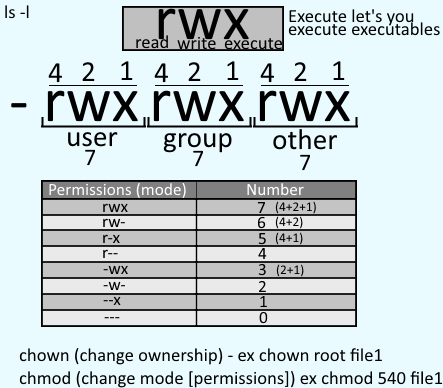
Freekb Linux Commands Chmod Change A File Or Directory Standard Permissions

Understanding File Permissions 2buntu

How To Set And Manage File Permission In Linux Part 1

Chown And Chmod Command Usage In Linux System Develop Paper

A Unix And Linux Permissions Primer Daniel Miessler
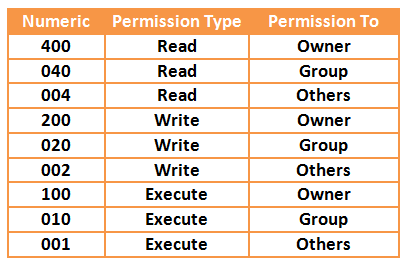
Your Own Linux Chmod Basics Of Files Directories Permissions And Use Of Chmod

Chmod Command In Linux With Examples Geeksforgeeks

How To Chown Recursively On Linux Devconnected

Chmod 777 A Definitive Guide To File Permissions

Linux Permissions An Introduction To Chmod Enable Sysadmin

Permissions In Linux Geeksforgeeks

What Is Chmod 777 How To Change File Permissions For Linux Tech Ninja Pro

Linux Unix Permissions And Attributes Linuxsecrets

Use Of Chmod Command In Linux Devopsdex

Understanding File Permissions

Linux Chmod Example Linux Hint

Chmod 777 In Terminal The Command To Make All Changes Affect Every File And Folder Ask Ubuntu

Understanding Linux Permissions And Chmod Usage

Command Line Understanding Chmod Symbolic Notation And Use Of Octal Ask Ubuntu

How Did The Number 777 In Chmod 777 Come Out Under Linux Laptrinhx

Ddg Gives You A Cheat Sheet For Any Chmod Configuration Good For Noobs Like Me Linux

Understanding Linux Permissions And Chmod Usage

Learning The Shell Lesson 9 Permissions
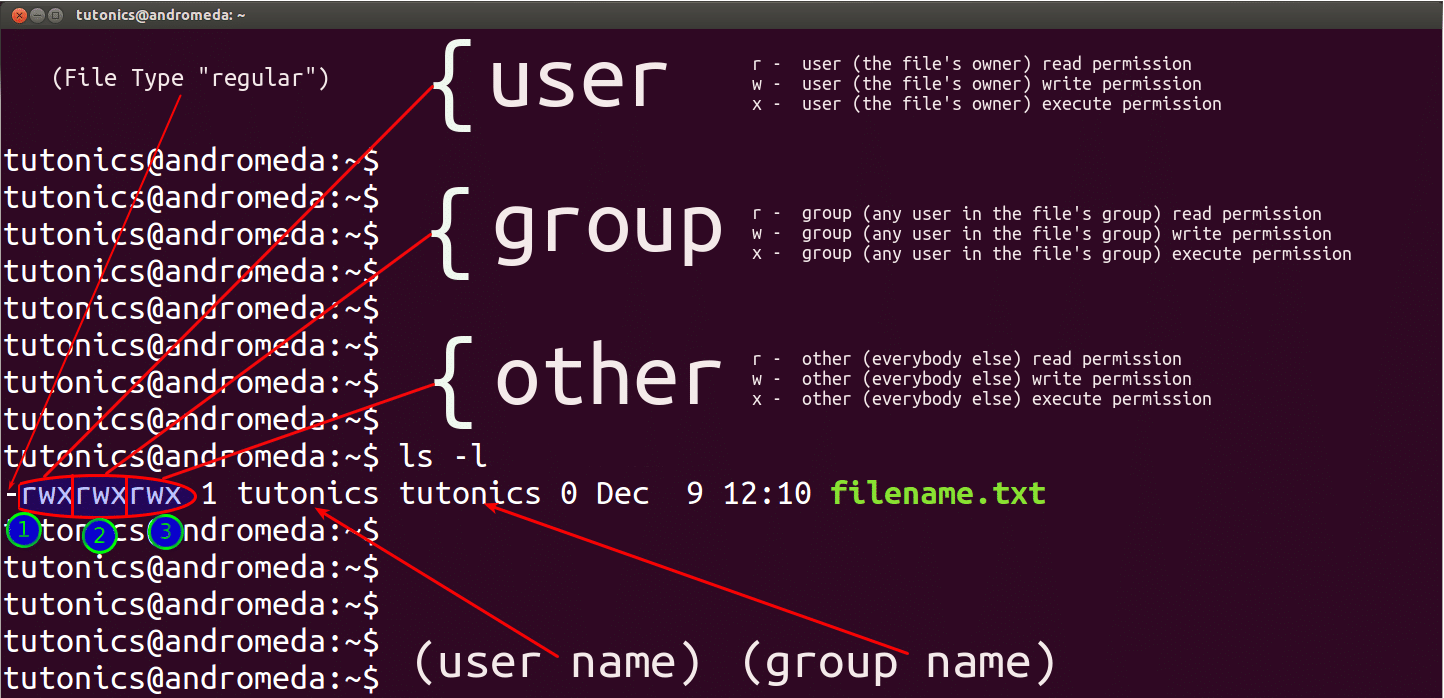
Linux File Permissions Tutorial For Beginners

Linux Chmod Command Linuxfordevices

Understand Linux File Permissions Using Chmod And Chown Commands Programming Tips For Versatile Coders

Modify File Permissions With Chmod Linode

Linux Permissions Guide Plex Support
Why Would Using Chmod 777 Recursively From The Root Cause A Linux Box To Not Boot I Could Understand This If I Were Limiting Permissions But Why Would Adding Permissions Cause This

Chmod 777 What Does It Really Mean Make Tech Easier

Unix Permissions The Easy Way Index Of All Chmod Permutations By Semi Koen Sep Towards Data Science

How To Get Octal File Permissions From Command Line In Mac Os Osxdaily

Linux File Permission Change By Chmod Command In Linux Guide For Beginners

Linux File Permissions And Chmod Doug Vitale Tech Blog

What Is Chmod 777

Change Permissions Of Files And Folders In Filezilla In Your Linux Hosting

Chmod Wikipedia
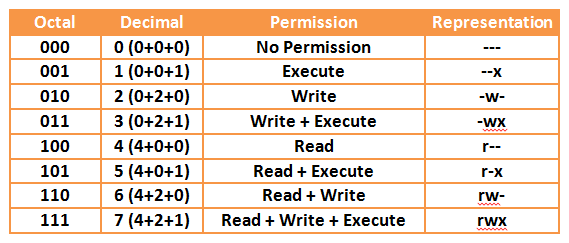
Your Own Linux Chmod Basics Of Files Directories Permissions And Use Of Chmod

Linux Users And Groups Linode

Understanding Linux File Permissions With Chmod Umask Chown And Chgrp Liquidon Net

Understanding Linux Permissions And Chmod Usage

Chmod Easy File Access Permissions And Modification In Linux 5 0 Raviolican

Fun With Numbers In Chmod

What Is Chmod How To Use Chmod For Wordpress File Permissions

How To Use Chmod Command In Linux Explained With Examples
.png)
File Permissions In Linux Unix With Example

Chmod Sanjogblog

Is There A Web Based Converter Between Rwx And The Octal Version Unix Linux Stack Exchange

How To Use The Chmod Command On Linux

Linux Users And Groups Linode

How To Use Linux File Permissions And Ownership On Alibaba Cloud Ecs Dzone Open Source
Q Tbn 3aand9gcq1nsq3kxri7ryrifobs2rfobawbv4hezfw9 Ldf4feblahyn09 Usqp Cau

Linux File Permission Javatpoint

Command Line Understanding Chmod Symbolic Notation And Use Of Octal Ask Ubuntu

What Does Chmod 777 Mean Linuxize

Linux File Permission Management Summary Programmer Sought
:max_bytes(150000):strip_icc()/i7guGwCYcn-34e068e148ae4e918b29c86cd2d5740e.png)
Configuring Unix Linux File And Directory Access Rights

Chmod 777 755 655 644 And More Permissions Linux Files Tutorials
Q Tbn 3aand9gcq6mtqrr2tbkvj8mt7j61itbsugnnfl3ltc9cdgqfgdswx0kkor Usqp Cau

8 Linux Chmod Command Examples To Understand It The Linux Juggernaut

Chown And Chmod Command Usage In Linux System Develop Paper

How To Use Chmod Command In Linux Explained With Examples

An Introduction To Linux File Permissions Boolean World

Permissions In Linux Geeksforgeeks

Linux And Unix Chmod Command Knowledge Hub

9 Quick Chmod Command Examples In Linux

Chmod Cheatsheet Linux

How To Use Chmod Command In Linux Explained With Examples

Linux Commands Chmod

14 Permission And Modification Times

Unix Linux Os X File Permissions

How To Change Directory Permissions In Linux Pluralsight

Chown Command In Linux Unix Explained With Examples The Linux Juggernaut
1

How To Change Directory Permissions In Linux Pluralsight

Pin By Dr Stefan Gruenwald On Cheatsheets Computer Science Programming Learn Javascript Linux Operating System

Understanding Basic File Permissions And Ownership In Linux The Geek Diary



